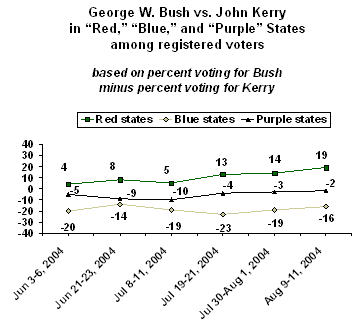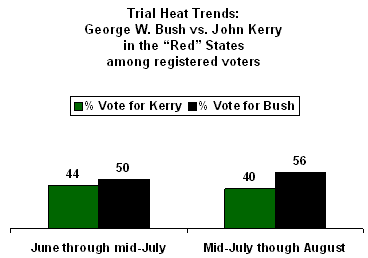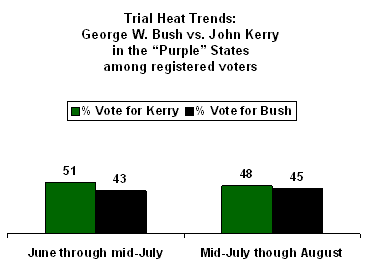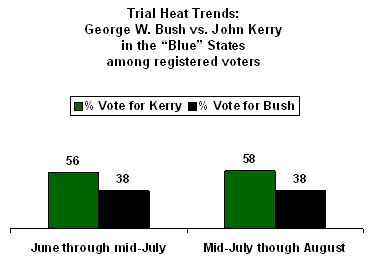GALLUP NEWS SERVICE
PRINCETON, NJ -- George W. Bush has over the last two months consolidated his base vote in core Republican states and made slight inroads in swing states in the process of moving to a somewhat more competitive position against John Kerry.
This conclusion is based on a comparison of more than 3,500 interviews (including 3,141 registered voters), conducted in three CNN/USA Today/Gallup polls from mid-July through Aug. 11, with a group of more than 3,000 interviews (including 2,696 registered voters), conducted in three polls in June and early July.
Among all registered voters nationwide, the most recent three polls show Kerry with an average one-point lead over Bush -- 48% to 47%. Kerry's average lead among the three polls before that (in June and early July) was six points, 50% to 44%.


Thus, in broad terms, it appears that Bush ended the period surrounding the Democratic convention in a slightly more competitive position with Kerry than he did in the weeks leading up to the Democratic convention.
An analysis of these results at the state level suggests that Bush's inroads on Kerry among registered voters overall resulted from a significant increase in Bush support in core Republican states, and a modest increase in the so-called showdown states. There has been no change in the positioning of the candidates in the core Democratic states.

Bush's average lead over Kerry in the Republican "red" states (ones in which Bush won over Al Gore by more than five percentage points in 2000) was six points in the June and early July polls. His lead over Kerry grew to an average of 15 points in the three most recent polls.

There has been a less substantial increase in Bush's margin over Kerry in the showdown states (ones in which the margin in the 2000 election was less than six points). Kerry led by eight points in these states in the earlier group of polls, and he leads by three points in the most recent set.

There has been no change in the race in the Democratic "blue" states (ones that Gore won over Bush by more than five points in 2000). Kerry led Bush by an average of 18 points in the earlier group of polls and leads by an average of 19 points in the most recent polls.

These registered voter data suggest that above all else, Bush has been able to consolidate his base in core Republican states. The overall impact of this type of consolidation on the election outcome, of course, is theoretically minimal because turnout and size of victory don't matter as long as Bush retains 50% +1 of the votes cast in each of these states.
Similarly, Kerry's having held on to his substantial lead in the core Democratic states in theory has no impact on the race, as long as that lead does not shrink to the point that it places any of these core states in jeopardy for the Democratic ticket in November.
But signs of Bush progress in the swing states are more significant to the race's outcome. The shift has been slight, to be sure, from a situation in which Bush was down by eight points to a situation in which he is down by three points. And, changes in the ballot within broad state groupings can be misleading. A candidate can gain overall among the group of swing states and not gain in terms of electoral votes if all gains are in one or two large states. The gains need to be distributed across specific states such that these states tip from one candidate to the other.
Still, above all else, the current data suggest that the race is quite close in competitive states. Gore received 49% of the vote in these same showdown states in 2000, compared with Bush's 48%. So Kerry is in roughly the same position that Gore was in four years ago. The battle for the electoral votes in several of these states in 2000 was, of course, extremely close, and the 2000 election in the final analysis hinged on just thousands of votes in states such as Florida, Wisconsin, New Mexico, Iowa, and Oregon. The data we have now suggest that the possibility for such razor-thin margins exists again this year.
Survey Methods
Results are based on telephone interviews with 3,540 national adults, aged 18 and older, conducted July 19-21, July 30-Aug. 1, and Aug. 9-11, 2004. For results based on the total sample of national adults, one can say with 95% confidence that the margin of sampling error is ±2 percentage points. For results based on the sample of 3,141 registered voters, the maximum margin of sampling error is ±2 percentage points.
Results are based on telephone interviews with 3,010 national adults, aged 18 and older, conducted June 3-6, June 21-23, and July 8-11, 2004. For results based on the total sample of national adults, one can say with 95% confidence that the margin of sampling error is ±2 percentage points. For results based on the sample of 2,696 registered voters, the maximum margin of sampling error is ±2 percentage points.
In addition to sampling error, question wording and practical difficulties in conducting surveys can introduce error or bias into the findings of public opinion polls.
